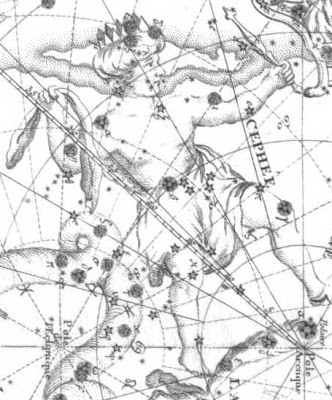 King Cepheus, in an 18th century star atlas
King Cepheus, in an 18th century star atlas
Image courtesy of G.M. Caglieris
In the night sky, Cepheus (pronounced SEE fee yuss) keeps his mythological family close: Cassiopeia, Andromeda, and Perseus are also immortalized as constellations and the four star groups are known collectively as “the Royal Family.” Cepheus and Cassiopeia are circumpolar constellations. As explained in a previous post, circumpolar constellations appear to circle the North Celestial Pole, which is conveniently marked for us by Polaris, the North Star.
Since it is a somewhat dim constellation, Cepheus is best observed when it‘s high in the sky. It will be dipping down closer to the horizon in spring and summer, so let’s close out January by paying homage to the king.
1) You’ll need to know where north is. If you don’t have a compass, take note of where the sun sets, which is approximately west. Stand with your left shoulder to the west, and you will be facing approximately north.
2) Wait until one hour after sunset to begin observing, so the sky is good and dark. The waning (shrinking) moon won’t rise until about an hour and a half later on Thursday the 24th, and then later each night as the week progresses. This late-rising moon will give you plenty of time to observe dim Cepheus in a dark sky.

3) Face north and tilt your head all the way back until you are looking at the zenith, the point in the sky that is directly above your head. Then slowly lower your head about one-quarter of the way down toward the northern horizon and then turn it slightly to the west. You should spot a sprawling “M” pattern in the sky. This is the Lazy W asterism (prominent star pattern) of the constellation Cassiopeia, but it will be upside down because it is in mid-revolution around the North Star.
4) If you can find the queen, you can find the king. The open arms of the Lazy W (the bottom of the M, in the current orientation) point toward Cepheus. The defining asterism that helps us locate Cepheus is called The House. It looks like a child’s drawing of a house: a square-like shape with a triangular pointed roof. Since the Lazy W will be upside down when you see it, The House will be under the M, on its side, with the peak of the roof pointing to the ‘right,’ relative to the M. Can you see the house shape? If you’re having trouble, avoid all white light for about 20 minutes to ensure that your eyes are dark adapted for optimum night vision. This will aid you in spotting dim stars.

5) Let’s look at the three brightest stars in Cepheus. They lie in a line, from the peak of the house to its base, along the ‘right’ side of the house (if it were oriented normally, with floor down and roof up). The star at the peak of the roof is Errai (pronounced uh RYE) from the Arabic for shepherd. A Jupiter-sized planet has been discovered orbiting Errai. The next star in the line is Alfirk (pronounced all FURRK), Arabic for flock. Alfirk is a pulsating blue giant. The ancient Arabs thought the stars in the vicinity of the North Pole represented a shepherd and his flock of sheep, which explains why some of the Arabic star names in Cepheus are pastoral in nature. The third star in the line, at the base of the house, is the brightest star in Cepheus, Alderamin. Alderamin (pronounced ull-derr-ah-MEEN) is from the Arabic for right forearm. This white dwarf star is spinning furiously--125 times faster than our Sun spins!
6) If you draw an imaginary line from Alderamin to Alfirk and continue past Alfirk about twice more the distance between the two stars, you will come to a star that is a bit brighter than Alderamin. This is Polaris, the North Star.
In about 5500 years, Alderamin will be our pole star, our North Star, replacing Polaris. That’s right, Polaris has a limited engagement. This change will occur because, as planet Earth spins on its axis, it wobbles slightly like a top. This means that, over time, our axis inscribes a small circle and points at different locations in the sky. If we’re lucky--as we are now with Polaris--that circle intersects with various stars that we Earthlings can use as North Stars, convenient visual and navigational markers for north.
7) At the base of The House of Cepheus, midway between Alderamin and the other (nameless) base star and also slightly below them, is a crown jewel of a star. The Garnet Star is one of the reddest stars in the sky and certainly one of the reddest stars that can be seen naked eye. Can you spot it? You may not see any color while looking at it naked eye. However, if you gaze at a magnified view of this star through binoculars or a telescope, its distinctive color will be revealed. It can vary from deep red to copper, depending on atmospheric conditions and the quality of your sky.
The Garnet Star is a red supergiant, discovered by Sir William Herschel, the famed British astronomer who also discovered the planet Uranus. The Garnet Star is so immense that if it were dropped in our solar system in the Sun’s position, it would extend beyond the orbit of Jupiter. Its great size pretty much ensures it will go out with a bang in the most cataclysmic of cosmic events: a supernova explosion. Enjoy the pretty bauble, while it lasts.